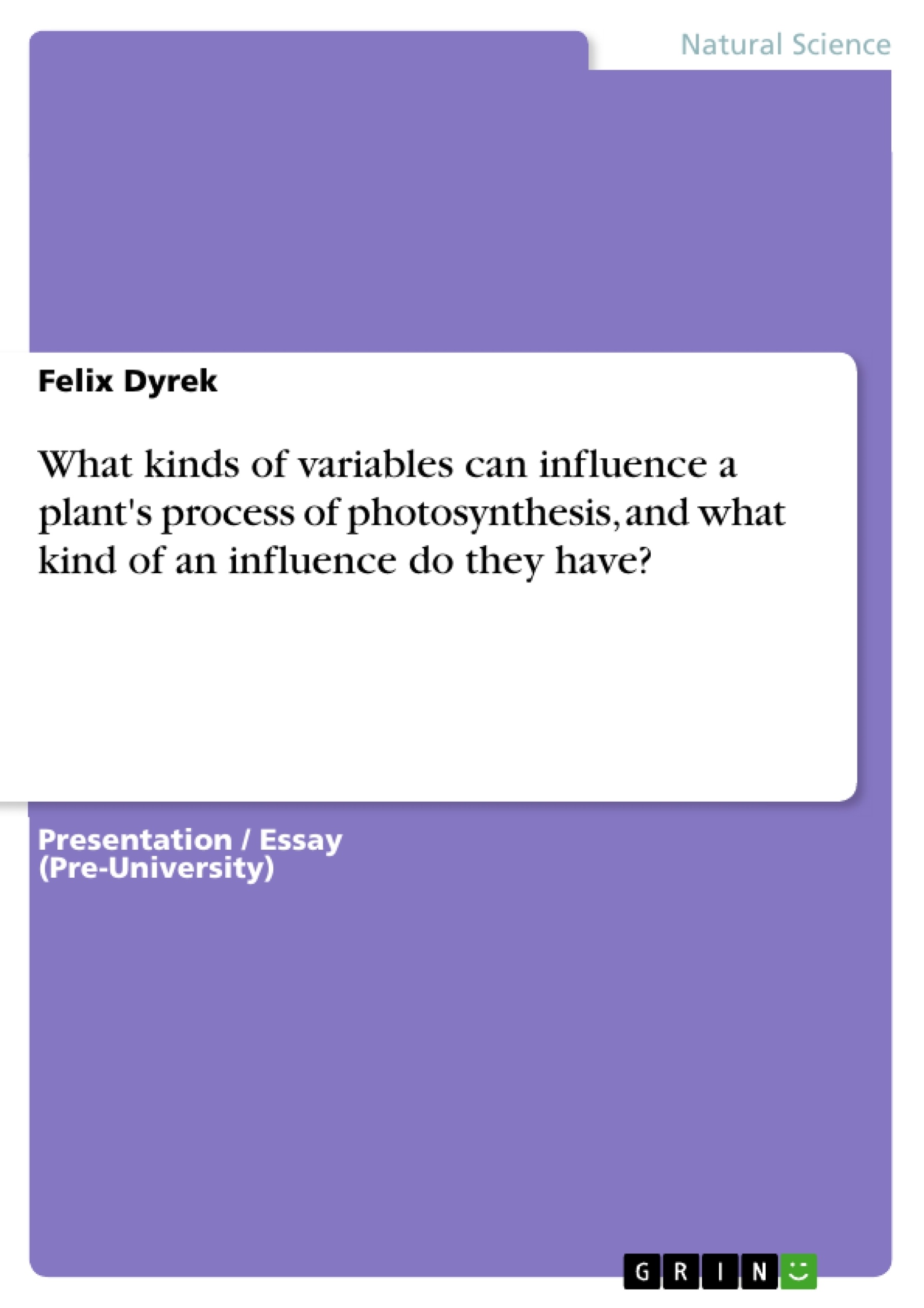Photosynthesis is the process a plant uses to combine sunlight, water, and carbon dioxide to produce oxygen and sugar (energy).
Investigation Photosynthesis
Introduction:
Photosynthesis is the process a plant uses to combine sunlight, water, and carbon dioxide to produce oxygen and sugar (energy).
Research Question:
What kinds of variables can influence a plant's process of photosynthesis, and what kind of an influence do they have?
Hypothesis:
If samples of Elodea canadensis (Canadian pond weed) are placed in distilled water and tap water, and have light from various distances come into contact with them, then the samples in the tap water will produce more bubbles than the ones in the distilled water, and also more bubbles will be produced when the distance between the light and the pond weed is reduced.
Hypothesis Explanation:
The bubbles that appear to come out from the pond weed are proof that oxygen is being produced, which is a product of photosynthesis. This way it is known that the process is taking place. If the source of light is closer to the plant, the more intense the light is and the rate of photosynthesis should quicken. Also, distilled water is essentially just hydrogen and oxygen molecules, because the other compounds have evaporated when the water was distilled. Tap water, however, is hard water, meaning it is rich in dissolved minerals, especially calcium and magnesium. Tap water in Poland is especially hard and it is recommended not to drink it. A couple of minerals are actually required for healthy plant growth and for maximizing the rates of photosynthesis, so this is why more bubbles would appear in the tap water.
Compounds
- 125 mL distilled water
- 125 mL tap water
- a couple pieces of Elodea canadensis
- 1 desk lamp (light source)
Variables
Dependent:
- the rate of photosynthesis
Independent:
- the light intensity
Controlled:
- amount of water
- water temperature
Apparatus
- 1 lab apron
- 1 pair of scissors
- 2 beakers
- 1 stopwatch
- 1 ruler
- 1 pencil and paper to record data
Method
1. Put on apron.
2. Pour the 125mL of distilled water into one beaker and the 125mL of tap water into the other beaker.
3. Using the scissors, cut the Elodea canadensis into two pieces, so that they each fit into the beakers.
4. Place one piece of Elodea canadensis each the beaker with distilled water.
5. Using your stopwatch, let the plant assimilate to the water for three minutes.
6. While these three minutes are passing, set up the lamp by plugging it in and turning it on.
7. Once the three minutes are up, stop the stopwatch, reset it and take the beaker with the distilled water and place it by the lamp.
8. With the ruler, measure out a 20cm distance between both objects and adjust the lamp so that the light is directed towards the beaker .
9. Start your stopwatch. For the first minute, let the pond weed again assimilate, this time to the light. Then, when the stopwatch reaches the one-minute mark, start counting the bubbles that the Elodea canadensis emits. After the remaining two minutes are up, stop counting and record your results.
10. Repeat steps 4 through 9, but this time using tap water.
11. Repeat steps 4 through 10, but this time the distance between the lamp and the beaker should be 10cm instead of 20cm.
12. Clean up after your experiment.
Frequently asked questions
What is the investigation about?
The investigation focuses on photosynthesis in Elodea canadensis (Canadian pond weed) and how different variables influence this process.
What is the research question?
The research question is: What kinds of variables can influence a plant's process of photosynthesis, and what kind of an influence do they have?
What is the hypothesis?
The hypothesis is that Elodea canadensis in tap water will produce more bubbles (oxygen) than in distilled water, and more bubbles will be produced when the light source is closer to the plant.
What are the key compounds used in the experiment?
The key compounds are 125 mL of distilled water, 125 mL of tap water, and pieces of Elodea canadensis. A desk lamp is used as the light source.
What are the variables in the experiment?
The dependent variable is the rate of photosynthesis. The independent variable is the light intensity. The controlled variables are the amount of water and the water temperature.
What apparatus is required for the experiment?
The apparatus includes a lab apron, scissors, two beakers, a stopwatch, a ruler, and a pencil and paper for recording data.
What is the method used in the experiment?
The method involves placing Elodea canadensis in distilled and tap water, exposing them to light at varying distances (20cm and 10cm), and counting the number of bubbles produced over a two-minute period after a one-minute assimilation period.
What is the purpose of the experiment?
The experiment aims to observe and quantify the impact of light intensity and water type (distilled vs. tap) on the rate of photosynthesis in Elodea canadensis, as indicated by oxygen production (bubbles).
- Citar trabajo
- Felix Dyrek (Autor), 2008, What kinds of variables can influence a plant's process of photosynthesis, and what kind of an influence do they have?, Múnich, GRIN Verlag, https://www.grin.com/document/159586



